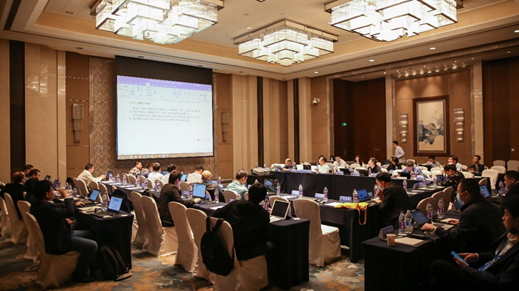The New Technologies Made Drop Optical Fiber Cable “Fly” into the Ordinary People's “Digital Family”
Recently, the draft of the revision project of the communication industry standard YD/T 1997.1 “Drop Optical Fiber Cables for Telecommunication Part 1: Bow-type Optical Fiber Cables” was reviewed and approved at the 78th meeting of the Cable Working Group(WG3) of the Transport & Access Network Technical Committee(TC6) of the China Communications Standards Association. This standard was spearheaded by FiberHome, and several enterprises, testing institutions and operators also participated in the discussion and drafting. It will play a role in regulating and guiding in the design, production and testing of the new generation of Bow-type optical cables, and also further promote China’s FTTH (Fiber to the Home) upgrade to FTTR (Fiber to the Room).

Pic.1 Conferencing
The Bow-type optical fiber cable is named for its butterfly-like cross-sectional appearance, and it’s the predominant product in FTTH construction for its advantages of small outer diameter, light weight, low cost, reliable performance, easy laying, etc. With the continuous advancement of FTTH construction, the demand for butterfly optical cables has also increased year after year. The quantity of domestic operators' centralized procurement increased by 270% from 2.03 million core kilometers in 2013 to 7.518 million core kilometers in 2019. On April 17, 2021, 16 ministries and commissions including the Ministry of Housing and Urban-Rural Development jointly issued the "Guiding Opinions on Accelerating the Development of Digital Homes and Improving the Quality of Living". The digitalization of homes will be further developed, and bow-type optical cables will also be more widely used.
The current version of YD/T 1997.1 “Drop Optical Fiber Cables for Telecommunication Part 1: Bow-type Optical Fiber Cables” is the 2014 version, and it has been 7 years since. With the development of FTTH and the network upgrade to FTTH, some new product structures derived from the older ones due to the complex application environment. On account of different application environments and extremely product differences among manufacturers, the standard was revised, and the specifications for the new bow-type optical fiber cable were added also:

Pic.2 Schematic diagram of fiber optic cable entry scenario
1) Invisible Bow-type drop optical fiber cable: the invisible bow-type drop optical fiber cable is a new bow-type cable for indoor wiring. The cable has invisible optical fiber unit, and it can be installed in the corridor and has no destructive effect on room decoration. Invisible Bow-type drop optical fiber cable is the preferred optical cable product for existing building’s FTTR (fiber to the room) network transformation.
2) Bow-type Optical Fiber Cable for 5G: The 1.6mm*2.1mm 5G bow-type optical fiber cable is a small-size bow-type optical cable that derived from the existing 5G construction. The optical cable is combined with the power conductors to form an optical and electrical hybrid cable. It is the mainstream product used in the current 5G construction.
3) Parallel Structure Bow-type Drop Optical Fiber Cable, Long-span Weather-Resistant Bow-type Drop Optical Fiber Cable: These two kinds of drop optical fiber cables can satisfy some niche markets. The TV signals and data signals are transmitted separately in one single time of construction, with the help of the parallel structure bow-type drop optical fiber cable. And the long-span weather-resistant bow-type drop optical fiber cable can meet the construction and application requirements of FTTH network in remote rural areas because of its high tensile strength and wear resistance.
As a state-owned enterprise in the field of optical communications, FiberHome attaches great importance to standards work. It has led or participated in the formulation of more than 30 international standards, more than 100 national standards, and over 300 industry standards. Among them, the standards related to access network includes, “Broadband Optical Access Network and Architecture and General Requirements for FTTH”, “Drop Optical Fiber Cables for Telecommunication Part 2: Round-type Optical Fiber Cables”, “Technical Requirements for Access Network---Passive Optical Network Base on Ethernet (EPON)” and so on. In the future, FiberHome will continue to maintain close cooperation with operators, research and design units, testing institutions and various enterprises, and contribute to the standardization of optical communication products in China and the world.